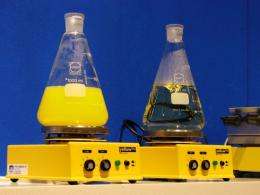Safe and scientifically sound

In August, federal officials sent a letter to Yale University formally criticizing its safety practices in connection to the accidental death of a student.
Undergraduate physics and chemistry major Michele Dufault was just weeks away from graduation when she died inside of a campus laboratory in April from injuries caused by a lathe -- a mechanical tool used for cutting and shaping materials.
The Occupational Safety and Health Administration said the lathe that was used by Dufault did not meet required safety standards, a finding that Yale currently disputes. OSHA could not fine or impose other penalties on Yale because the student was not an employee of the university. However, Dufault's death, along with several other high-profile laboratory deaths, has left universities wondering how best to keep students safe.
Each year, colleges and universities must teach thousands of undergraduates proper lab safety protocols, which can vary widely between different schools and disciplines. Universities must also impart this information in very limited amounts of time, says Sheila Kennedy, the director of lab safety in the chemistry department at the University of California, San Diego, which can make it difficult for students to absorb everything they need to know to stay safe while in the lab. The goal of any lab safety program is to help students identify and minimize their exposure to any hazards. Kennedy said her campus uses a variety of techniques from lectures to web tutorials to help explain lab safety essentials. Although the bulk of formal lab safety training is concentrated at the beginning of the term, learning continues throughout the course.
"Rather than teaching safety, you teach chemistry -- with one eye on safety," Kennedy said.
P.J. Alaimo, a chemist at Seattle University, also seeks to create a culture of safety in his research lab. Alaimo said that most professors are "mainly concerned with compliance [with legal standards] and not a whole lot more than that. That’s not to say they didn’t want their students not to get hurt, but safety always came secondary to the science."
He believes that labs can do better than settling for just compliance.
Alaimo's solution is to create "safety teams." Instead of the instructor going over any safety issues at the beginning of each lab, Alaimo tasks two or three students to research and present the safety talk. Alaimo said that this approach has transformed how students think about safety. Instead of passively waiting for an instructor to tell them what to do, the students have collectively shouldered some of this responsibility. The students actively question lab procedures, and they have integrated safety concerns into how they think about doing experiments. Alaimo said that now, “students are thinking about safety as part of experimental design.”
"A lot of people design their experiments with a 'safety first' mindset," Alaimo said. "But most people don't involve undergraduates in that process."
Educators hope that new and innovative ways of teaching about lab safety may help students learn the material better, but there is no documentation as to whether these new methods actually prevent accidents and injuries in the lab. Ironically, the fact that teaching labs have so few incidents makes it harder to measure the impact of new teaching methods; proper research requires collecting a copious amount of data over a long period of time in order to determine whether new methods have actually improved lab safety. Because this process is expensive, and time-consuming, university scientists have little or no results on the best way to keep students safe.
Nancy Wayne, chairperson of the University of California Center for Laboratory Safety and a physiologist at UCLA, said that lack of awareness is another reason evidence-based safety practices don't exist.
"For a lot of [scientists], including myself, lab safety was very important but it wasn't something we thought about all the time," Wayne said.
The University of California Center for Lab Safety wants to fix this mindset, both by bringing safety to the forefront of thinking and by developing evidence-based lab safety practices. Having this data will also help scientists implement these practices in their labs, said executive director James Gibson.
"[Scientists] had a lot of questions about the things we were putting into place, and what kind of proof we had that these things would work,” Gibson said.
That data doesn’t yet exist, although Gibson and Wayne hope to change that.
Although ensuring lab safety depends on the type of lab, science research, and experiment in process, professors say a few basic steps can help prevent a majority of mishaps. To Kennedy, the solution is a matter of “close supervision.” It sounds obvious, Kennedy said, but having a teaching assistant or professor nearby can often keep minor issues from becoming major ones.
To Alaimo, students can go a long way in ensuring safety by knowing their limits. Attempts to single-handedly manage something like a small spill may inadvertently make things worse if a student isn't cleaning it up properly. Students need to understand when it's time to ask for help and get someone more experienced, he said. Plan for safety before you start your experiment, Alaimo say,. "Safe experiments don't just happen, they have to be designed."
"Most labs are quite safe," Kennedy said. "We always tell students as they're leaving safety training that going out and driving their car is far more dangerous statistically than anything they're likely to do in the lab."
Provided by Inside Science News Service

















